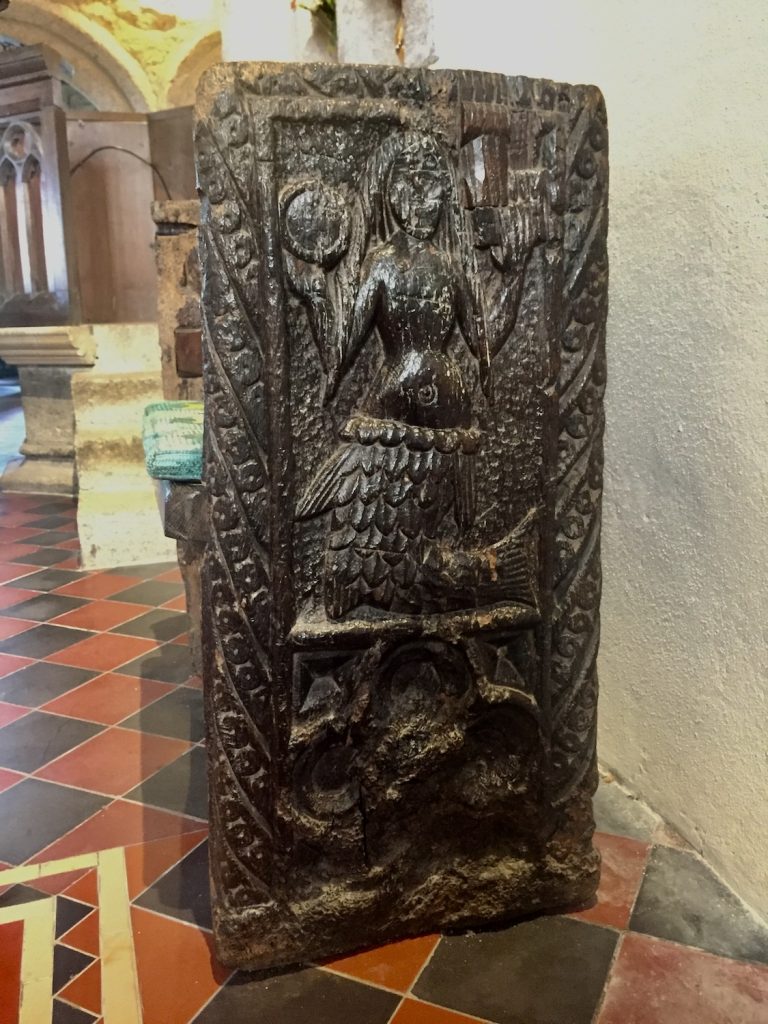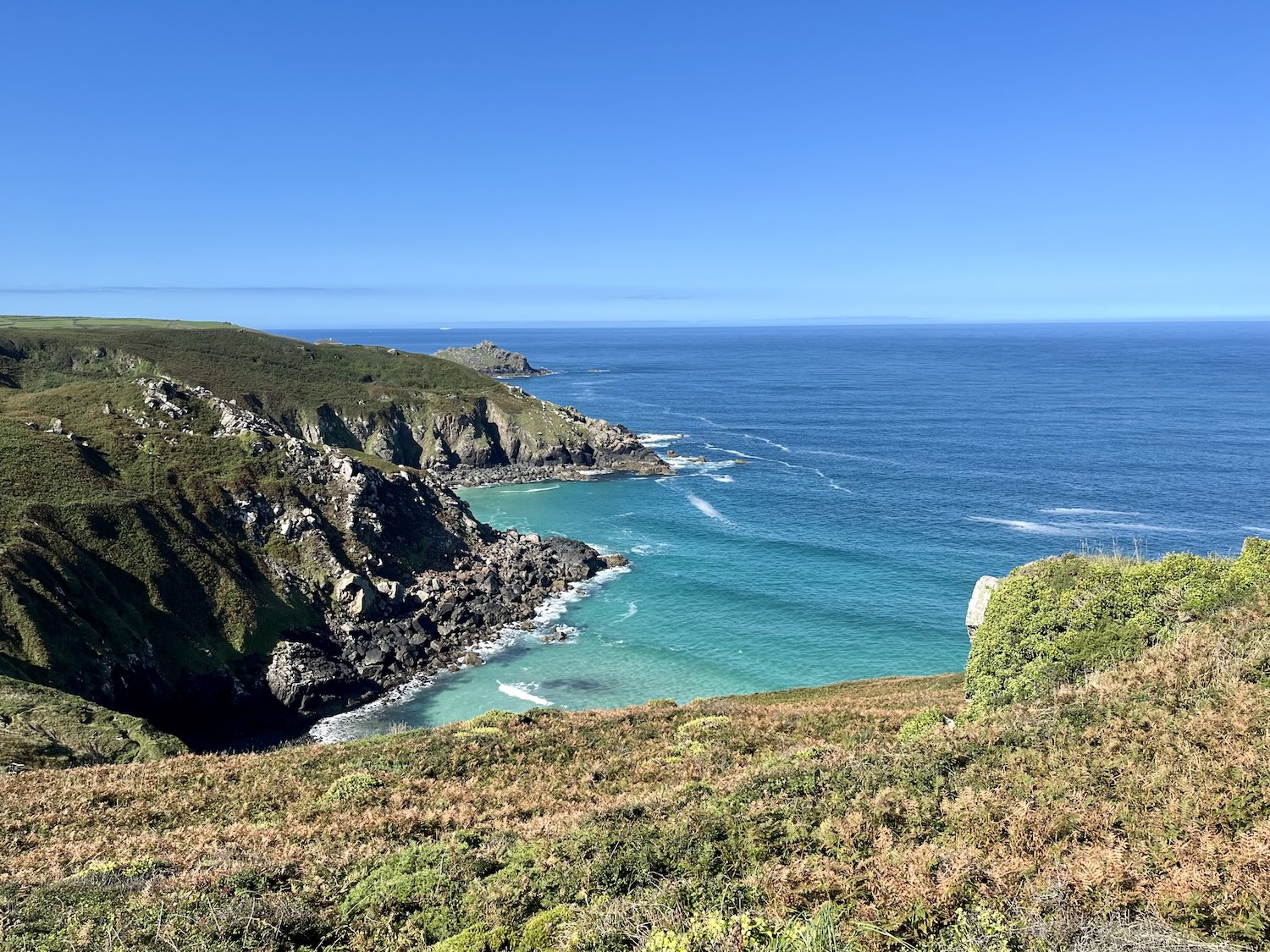Cornwall is steeped in folklore and being a peninsula means it has plenty of fey creatures making their home in the sea. Come with me on a trip to Zennor to meet one mermaid and discover how the folklore has inspired my writing.
A day trip to Zennor
Past St Ives, the picturesque coastal road winds along to the village of Zennor. My last visit here was back in May 2019, when I lived at the other end of the county. The car trip then took two and a half hours. Now, from my new home, it’s about twenty minutes.
From the village (there is a car park with an honesty box which is £1 all day) the footpath leads to the coast path and the promontory named Zennor Head. To the west is Pendour Cove, which will feature in our mermaid tale.
Zennor’s name stems from St. Senara or Azenor. One tale says she was a Breton princess, wrongly accused of adultery. As punishment, her husband cast her out to sea in a barrel, even though she is pregnant. She gives birth to a son on the waves and washes up on this very spot. Some may have already noticed the stark similarities between this tale and the one of Danae and Perseus from Greek mythology. The Norman church is dedicated to her and evidence suggests a church has stood here since the 6th century. Inside, the wooden pews are much more recent, save for one particularly interesting chair.
The Mermaid’s Chair
One section of a 15th century pew remains with a carving of a mermaid holding a comb and a mirror. The carving supposedly relates to the romantic folktale of the Mermaid of Zennor and Matthew Trewhella. Young Matthew was the good-looking son of the churchwarden and was well known for his beautiful singing voice. He sang in the church choir every Sunday and that voice was said to draw in the crowd.

One Sunday, down on Pendour Cove, a mermaid lounged on the rocks and heard Matthew’s mesmerising singing voice drift down from the church above. Each Sunday after, the mermaid would visit the same rock just to listen to Matthew sing. The mermaid herself was beautiful and her voice too was hauntingly serene.
No longer content to sit on the rocks and listen, the mermaid ventured up the cliff, likely stole a dress left outside to dry to hide her tail and “walked” to the church. She visited frequently, growing bolder and staying longer to listen to Matthew sing until one day, his eyes met hers and it was love at first sight.
After the service, as the mermaid made her way to leave, Matthew confronted her and begged her to stay. It was then the mermaid confided who she was, and that she had to return to the sea. Matthew was so besotted he vowed he would follow. Taking her into his arms they went to Pendour Cove and beneath the waves never to be seen again. However, if you visit Pendour Cove you may still hear Matthew Trewhella’s singing.
Other versions of the story suggest the mermaid frequented the church long before Matthew appeared. She sang the sweetest of any who attended, but despite the passing of the years, she never aged. When Matthew Trewhella enters the story, her interest in this young man and his beautiful singing voice grows until one day he follows her home, never to be seen or heard of again. Many years later, a sailor is surprised by the appearance of a mermaid, asking for him to raise his anchor because it is blocking her front door and her children are inside (as someone who has had inconsiderate neighbours parking over the drive in the past, I can understand her frustration). The sailor obliges because mermaids are ill omens and a pissed off one is going to make matters a whole lot worse! When news of this travels around the village, they conclude she must be the same mermaid who enticed young Matthew back into her briny home.
Honestly, what likely happened is Matthew Trewhella eloped with someone his churchwarden father didn’t wholly approve of and the idea he was bewitched by a siren into the sea is a much better alternative fabrication to reality. Or, what’s more likely is Matthew Trewhella never existed and the whole thing is made up.
The Doom Bar
Mermaids appear in quite a few tales on the Cornish coast. Another famous story comes from Padstow. On the Camel Estuary is a sandbank named the Doom Bar. Ignore whatever you were taught in those geography lessons because this one was conjured up by a mermaid in a dying curse when she was shot by a sailor. The tale changes depending on the teller. In one, a man shoots her, mistaking her for a seal. In others, we encounter the usual “romantic” stories where entitled men go around asking women to marry them, and when they say no, they’re either raped or murdered. A man goes off with his new gun, looking for something to hunt and happens upon a beautiful woman. When she refuses his advances, he shoots her. Her curse affects the local area greatly. Hundreds of ships wreck on the Doom Bar and the estuary chokes with sand so now only small vessels can navigate its waters.
Mermaids in my fiction
In my current work in progress, the story takes place partly in Cornwall and partly in the fairy realm. Given the variety of folklore here, I wanted to make use of it. Merfolk exist in my world-building. However, I wanted to do things a little differently. The bones of our common folklore tales are there, but they are too often embellished with fiction or allegory, which are very often Christian morals. Take Arthur as an example. His origins lie in Welsh mythology, but a lot more was added which is likely to be mostly fictional. Or at the most, accounts of historical deeds condensed into one figurehead (think of when you watch a film based on a book and the writers have decided to merge three characters into a single person for simplicity).
So how do my merfolk differ?
For starters, they are more akin to other aquatic mammals like dolphins and seals. They cannot breathe underwater but can hold their breath for insane lengths of time. They have no body hair, but take great pains to cultivate an interesting pattern of barnacles or a luscious head of seaweed. Like the mermaids in myth, they’re avid people watchers but prefer to keep their distance. They use coves which are difficult for people to reach as places to relax and use the rock pools as safe places for their offspring to play.
The merfolk have only recently introduced themselves to this story, and I will enjoy getting to know them better.
Do you take inspiration from local folklore? How do you depict fairytale creatures in your writing?
